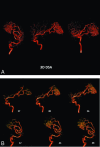Comparison of the Diagnostic Utility of 4D-DSA with Conventional 2D- and 3D-DSA in the Diagnosis of Cerebrovascular Abnormalities
- PMID: 28279986
- PMCID: PMC5389915
- DOI: 10.3174/ajnr.A5137
Comparison of the Diagnostic Utility of 4D-DSA with Conventional 2D- and 3D-DSA in the Diagnosis of Cerebrovascular Abnormalities
Abstract
Background and purpose: 4D-DSA is a time-resolved technique that allows viewing of a contrast bolus at any time and from any desired viewing angle. Our hypothesis was that the information content in a 4D-DSA reconstruction was essentially equivalent to that in a combination of 2D acquisitions and a 3D-DSA reconstruction.
Materials and methods: Twenty-six consecutive patients who had both 2D- and 3D-DSA acquisitions were included in the study. The angiography report was used to obtain diagnoses and characteristics of abnormalities. Diagnoses included AVM/AVFs, aneurysms, stenosis, and healthy individuals. 4D-DSA reconstructions were independently reviewed by 3 experienced observers who had no part in the clinical care. Using an electronic evaluation form, these observers recorded their assessments based only on the 4D reconstructions. The clinical evaluations were then compared with the 4D evaluations for diagnosis and lesion characteristics.
Results: Results showed both interrater and interclass agreements (κ = 0.813 and 0.858). Comparing the 4D diagnosis with the clinical diagnosis for the 3 observers yielded κ values of 0.906, 0.912, and 0.906. The κ values for agreement among the 3 observers for the type of abnormality were 0.949, 0.845, and 0.895. There was complete agreement on the presence of an abnormality between the clinical and 4D-DSA in 23/26 cases. In 2 cases, there were conflicting opinions.
Conclusions: In this study, the information content of 4D-DSA reconstructions was largely equivalent to that of the combined 2D/3D studies. The availability of 4D-DSA should reduce the requirement for 2D-DSA acquisitions.
© 2017 by American Journal of Neuroradiology.
Figures



References
-
- Fleiss JL. Measuring nominal scale agreement among many raters. Psychol Bull 1971;76:378–82 10.1037/h0031619 - DOI
Publication types
MeSH terms
Grants and funding
LinkOut - more resources
Full Text Sources
Other Literature Sources
